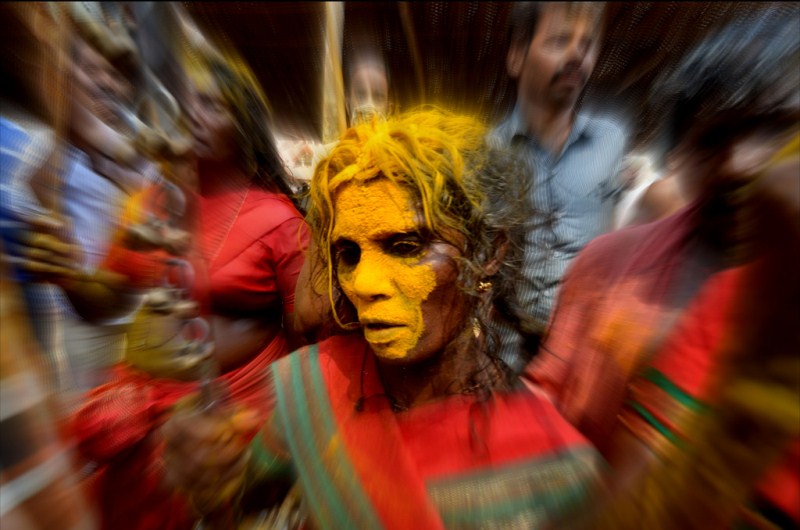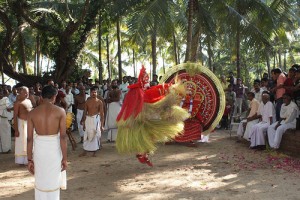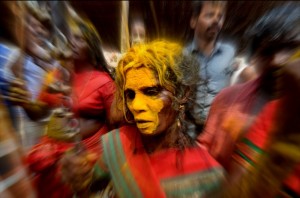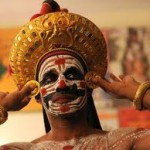Theyyam’s thumps up to Marxism
He breaks a coconut against his head, scythes himself on the forehead, wears a red-hot iron chain and jumps into a fire. Theyyam is a very physical performance bordering on the metaphysical for not just the performer, but for the audience as well who are instrumental in seeing the act to its successful completion. The dancer dresses himself up as a deity – in colourful masks made entirely of natural materials. The most important part of his costume is the ‘mudi’ or the head dress, wearing which he ‘becomes’ the deity. Staring into a small hand-held mirror, probably through auto suggestion, he slips into a different plane of existence altogether. As the performance progresses, he becomes the incarnate, the worldly manifestation of the divine. The most important stage of the performance is ‘mukhadarshanam’ or when the dancer sees the living face of the god which is followed by ruptures, ecstatic exclamations and frenzied motion.Theyyam does not confine itself to performance but is believed by the spectators to bring them divine assistance in times of need, ensure their physical safety and help resolve their conflicts. Thus Theyyam artists do more than just perform – they instil a new hope in life itself; ‘Theyyam’ is a corruption of the word ‘Daivam’ meaning ‘god.’ Traditionally, Theyyam performers come from the lower end of the caste spectrum – Velan, Parayan, Malayan, etc. Because they were the poorest of the poor, village Theyyams were the first to embrace the communist movement in Kerala. Though the performer is bestowed with divine powers temporarily, the ritual is not idol-centric. Probably it’s no coincidence that Kannur district where the form originated is a Marxist bastion.
Divinity of the lewd: Bharani Festival
Kannaki was a feisty woman who plucked out her breast when her husband was falsely implicated on charges of thieving royal jewels and sentenced to death. As per the Tamil classic ‘Silapathikaram’ Kannaki’s curse not just finished the King of Madurai but totalled his city to ashes. The Kodungallur Temple is believed to be a memorial to Kannaki; there is even a sealed underground vault which is believed to contain her mortal remains. The locals believe if anybody opens this vault, it will unleash catastrophes comparable to those of Tutankhamen. Then Kannaki or the secret vault is not top-of-mind during the seven-day celebration of the Bharani Festival at this temple during the Malayalam month of Meenam (between March and April) each year. During the ‘Kavu Theendal’ or ‘pollution ceremony’ overseen by the Kodungallur King himself, devotees run amok through the temple striking the rafters with sticks and throwing discarded objects over the roof of the temple into the sanctum sanctorum. This act of vandalism is accompanied by ‘Therippattu’ or obscene songs addressed to the temple deity. While some sing in hushed tones, most sing at the top of their voice. While there are many from even within the religious fold who are staunch opponents to this ages-old rite, social observers believe it to be cathartic for the rustic folk who form the bulk of the faithful. These farmers, just out of their back-breaking harvest season also believe this to be a fertility rite. Those who believe the Bharani Festival will die a natural death might have to wait a bit longer.The fun in poking fun: Ottan Thullal
What if you were ridiculed for dozing off during a cultural performance? You invent one so interesting nobody dozes off. Easier said than done. But Kunjan Nambiar, one of the greatest poets of Malayalam literature did just that.
Well, what actually made things worse was that Kunjan Nambiar was playing a part in the Chakyar Koothu show when he nodded off which irked the Chakyar so much that he ridiculed the poet no end. In Ottamthullal – which Jawaharlal Nehru once referred to as ‘poor man’s Kathakali’ probably for the ease of following it – Kunjan Nambiar criticised the prevailing injustices, made fun of officious landlords and other insensitive luminaries. In Ottamthullal a single performer dances to and sings the story which is repeated by his retinue ensuring that the audience do not miss out on the lyrics. The founder, a great man of word of the 18th century, gave it a literary flourish adding his own brand of wit and sarcasm to drive home the point – which drove the crowd to splits. Ottamthullal saw an immense upheaval in popularity but needless to say, the Chakyar was not exactly thrilled and complained to the King. The King decreed that it may not be performed at the local Ambalapuzha Temple and it’s not to this day.All photographs, except ‘Ancient, Arcane: Bharani Festival’ are from Google. The mentioned one is from www.thealternative.in

















